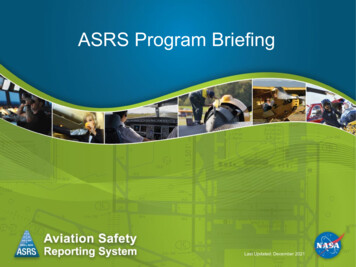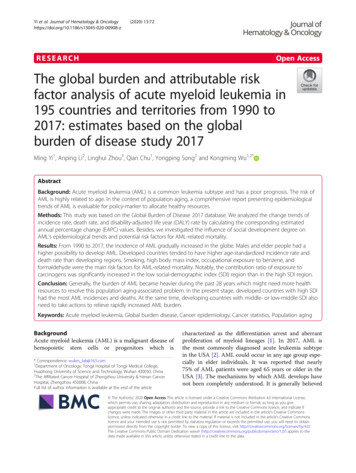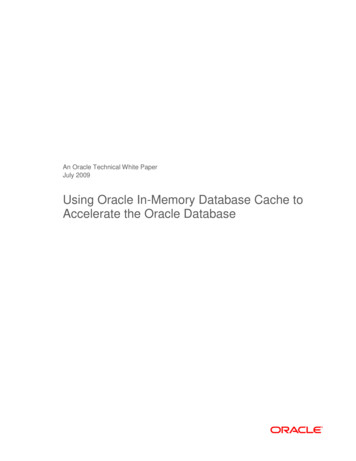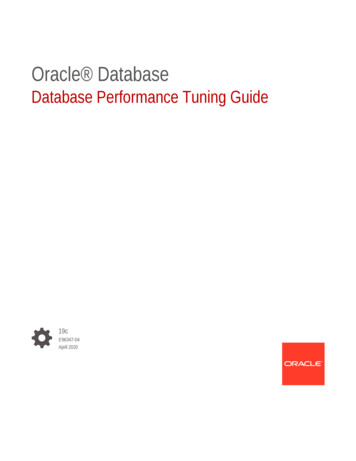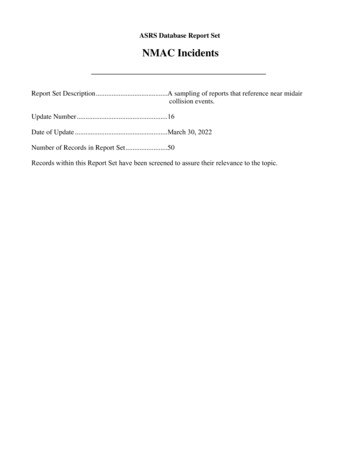
Transcription
ASRS Database Report SetNMAC IncidentsReport Set Description .A sampling of reports that reference near midaircollision events.Update Number .16Date of Update .March 30, 2022Number of Records in Report Set .50Records within this Report Set have been screened to assure their relevance to the topic.
National Aeronautics andSpace AdministrationAmes Research CenterMoffett Field, CA 94035-1000TH: 262-7MEMORANDUM FOR: Recipients of Aviation Safety Reporting System DataSUBJECT: Data Derived from ASRS ReportsThe attached material is furnished pursuant to a request for data from the NASA Aviation SafetyReporting System (ASRS). Recipients of this material are reminded when evaluating these dataof the following points.ASRS reports are submitted voluntarily. Such incidents are independently submitted and are notcorroborated by NASA, the FAA or NTSB. The existence in the ASRS database of reportsconcerning a specific topic cannot, therefore, be used to infer the prevalence of that problemwithin the National Airspace System.Information contained in reports submitted to ASRS may be clarified by further contact with theindividual who submitted them, but the information provided by the reporter is not investigatedfurther. Such information represents the perspective of the specific individual who is describingtheir experience and perception of a safety related event.After preliminary processing, all ASRS reports are de-identified and the identity of theindividual who submitted the report is permanently eliminated. All ASRS report processingsystems are designed to protect identifying information submitted by reporters; including names,company affiliations, and specific times of incident occurrence. After a report has been deidentified, any verification of information submitted to ASRS would be limited.The National Aeronautics and Space Administration and its ASRS current contractor, BoozAllen Hamilton, specifically disclaim any responsibility for any interpretation which may bemade by others of any material or data furnished by NASA in response to queries of the ASRSdatabase and related materials.Becky L. Hooey, DirectorNASA Aviation Safety Reporting System
CAVEAT REGARDING USE OF ASRS DATACertain caveats apply to the use of ASRS data. All ASRS reports are voluntarily submitted, andthus cannot be considered a measured random sample of the full population of like events. Forexample, we receive several thousand altitude deviation reports each year. This number maycomprise over half of all the altitude deviations that occur, or it may be just a small fraction oftotal occurrences.Moreover, not all pilots, controllers, mechanics, flight attendants, dispatchers or otherparticipants in the aviation system are equally aware of the ASRS or may be equally willing toreport. Thus, the data can reflect reporting biases. These biases, which are not fully known ormeasurable, may influence ASRS information. A safety problem such as near midair collisions(NMACs) may appear to be more highly concentrated in area “A” than area “B” simply becausethe airmen who operate in area “A” are more aware of the ASRS program and more inclined toreport should an NMAC occur. Any type of subjective, voluntary reporting will have theselimitations related to quantitative statistical analysis.One thing that can be known from ASRS data is that the number of reports received concerningspecific event types represents the lower measure of the true number of such events that areoccurring. For example, if ASRS receives 881 reports of track deviations in 2010 (this number ispurely hypothetical), then it can be known with some certainty that at least 881 such events haveoccurred in 2010. With these statistical limitations in mind, we believe that the real power ofASRS data is the qualitative information contained in report narratives. The pilots,controllers, and others who report tell us about aviation safety incidents and situations in detail –explaining what happened, and more importantly, why it happened. Using report narrativeseffectively requires an extra measure of study, but the knowledge derived is well worth the addedeffort.
Report Synopses
ACN: 1861615(1 of 50)SynopsisC152 pilot reported an NMAC and a wake turbulence encounter departing VNC.ACN: 1856701(2 of 50)SynopsisAir carrier Pilot reported seeing a UAS while descending in Class B airspace. The flightcontinued normally after the encounter.ACN: 1855155(3 of 50)SynopsisGA flight instructor with student reported an NMAC with an air carrier aircraft whiletraining in a practice area near GUM airport. The air carrier was on final approach to GUM.The conflict required evasive action.ACN: 1854859(4 of 50)SynopsisA L30 TRACON Controller reported issuing vectors to avoid an NMAC between two aircraftflying published RNAV procedures when the arriving aircraft "stayed high" on the arrival toLAS airport. The reporter states the CHOWW RNAV arrival procedure conflicts with theGIDGT RNAV SID.ACN: 1854851(5 of 50)SynopsisFlight crew reported an NMAC while on final approach. The crew stated that NMACs seemto be a common problem at the airport due to the high volume of VFR traffic.ACN: 1854850(6 of 50)SynopsisFalcon 900 Captain reported responding to a TCAS Resolution Advisory to climb, avoidinganother aircraft that was only detected by the TCAS system for a matter of seconds.
ACN: 1854841(7 of 50)SynopsisC172 pilot reported an NMAC after an aircraft turned the wrong way during a go-aroundand verbalized a lengthy radio call, preventing ATC from warning of traffic conflict.ACN: 1854840(8 of 50)SynopsisDA40 instructor pilot reported directing the student to climb to avoid a helicopter that wascleared by Tower into the traffic pattern at the same altitude.ACN: 1854839(9 of 50)SynopsisGA pilot reported an NMAC with another aircraft that had turned to a wrong heading andwas quickly corrected by ATC.ACN: 1854823(10 of 50)SynopsisSingle Engine Pilot reported a possible airspace violation and NMAC . The pilot cited thecomplicated airspace at this location and confusion with ATC instructions as contributing tothe event.ACN: 1854773(11 of 50)SynopsisGA student pilot reported an NMAC with a helicopter in the traffic pattern at a non-toweredairport while on takeoff.ACN: 1854747Synopsis(12 of 50)
C-172 instructor reported a student pilot on a solo flight had an NMAC event while on thelanding pattern training. The student mistakenly identified the wrong aircraft to follow forlanding resulting in a loss of separation and causing other aircraft to execute a go-around.ACN: 1854624(13 of 50)SynopsisAir carrier First Officer reported an NMAC on approach to MCI following an unstabilizedapproach.ACN: 1854368(14 of 50)SynopsisCorporate jet flight crew reported an NMAC on arrival into CMA after considerableconfusion regarding the runway in use.ACN: 1854208(15 of 50)SynopsisCessna 172 flight instructor reported an NMAC event that was caused by an ATC assignedheading. Flight Instructor executed an evasive maneuver to prevent a collision.ACN: 1854026(16 of 50)SynopsisAir taxi pilot reported a UAS passed by their aircraft when approaching to land. The pilotcontinued the approach and landed normally.ACN: 1853898(17 of 50)SynopsisAir Carrier pilots reported receiving an RA while descending. The pilot flying started aclimb until receiving " clear of conflict." The other aircraft was also an air carrier trackingtowards the reporting pilots. There was no alert from ATC according to the reporter.ACN: 1853801(18 of 50)
SynopsisGA instructor reported an NMAC while flying a high wing tail wheel aircraft. Descending toenter the CTAF traffic pattern immediate evasive action was needed to avoid an aircraftthat was climbing through the instructor's flight path.ACN: 1853790(19 of 50)SynopsisPilot reported a NMAC during takeoff. On their takeoff roll, an aircraft on downwind for theopposite runway turned a short base and final leg to land. All remaining taxiways for theinstructor were closed due to construction. The instructor became airborne and executedan evasive maneuver.ACN: 1853753(20 of 50)SynopsisLight aircraft pilot reported an NMAC in the pattern at LVK airport following an apparentmiscommunication with the Tower.ACN: 1853541(21 of 50)SynopsisGA pilot reported an NMAC while on the downwind at non-towered EDU requiring evasiveaction. The pilot of the other aircraft had reportedly not been communicating properly,which contributed to the event.ACN: 1853443(22 of 50)SynopsisEMB-145 Captain reported an NMAC during cruise requiring the crew to disengage theautopilot and execute a climb maneuver to clear the conflict. The conflicting VFR aircraftwas not in communication with ATC.ACN: 1853179Synopsis(23 of 50)
A Flight Instructor reported an NMAC event during initial climb with opposite directionlanding aircraft. Flight Instructor stated the landing aircraft provided inaccurate positionradio calls.ACN: 1853151(24 of 50)SynopsisGA pilot reported being notified of causing an NMAC event after landing at non-toweredairport GXY. Reporter stated no visual was traffic observed nor heard any traffic onUNICOM.ACN: 1852703(25 of 50)SynopsisTower Controller reported an NMAC requiring evasive action to avoid a collision.ACN: 1852696(26 of 50)SynopsisTower Controller reported an NMAC due to an aircraft turning in front of an arrival.ACN: 1852693(27 of 50)SynopsisTRACON Controller and an involved pilot reported an NMAC requiring evasive action.ACN: 1852637(28 of 50)SynopsisSR-20 pilot reported an NMAC event during final approach to a non-towered airport. Allrequired radio position reports were completed with no traffic responses received. On final,fight crew made visual contact with an opposite direction departure and executed anevasive maneuver.ACN: 1852306(29 of 50)
SynopsisAir carrier Captain reported an NMAC event after ATC assigned a level off during initialclimb after takeoff from MSP. The flight crew complied with the TCAS RA and notified ATC.ACN: 1852168(30 of 50)SynopsisPA-34 Flight Instructor reported an NMAC event during cruise as ATC was slow in providingvectors, that resulted in both aircraft executing evasive maneuvers.ACN: 1852164(31 of 50)SynopsisC172 flight instructor reported having to execute an evasive maneuver during an NMACevent while on visual approach as the other aircraft misidentified traffic, resulting in a lossof separation.ACN: 1851891(32 of 50)SynopsisCessna 172 pilot reported an NMAC event with a flight of three non-communicatingaircraft. Upon establishing visual contact with the formation, the Cessna pilot executed asuccessful evasive maneuver.ACN: 1851868(33 of 50)SynopsisGA pilot reported an NMAC event during takeoff with opposite direction glider landing onparallel runway at BDU non-towered airport.ACN: 1851565(34 of 50)SynopsisPilot reported an NMAC event while on ATC vector under Class B 4,000 ring at assignedaltitude of 3,000 feet. Pilot took evasive action to avoid a collision. Pilot indicated ATCassigned route and altitude was conducive to VFR traffic conflict.
ACN: 1851499(35 of 50)SynopsisHelicopter pilot reported an NMAC while turning onto final approach, which led the pilot totake evasive action and land on a parallel taxiway. Pilot stated that the Tower Controllerhad not advised of the conflicting aircraft.ACN: 1851489(36 of 50)SynopsisGeneral aviation pilot had a near miss with a UAS while on approach and took evasiveaction.ACN: 1851392(37 of 50)SynopsisCRJ200 Captain reported a near miss with a UAS while on descent to a Class B airport andreported to ATC.ACN: 1850971(38 of 50)SynopsisInstructor pilot reported a near mid air collision after missing several radio calls fromTower during routine training operations.ACN: 1850939(39 of 50)SynopsisFlight Instructor reported a near miss with a UAS while in the traffic pattern and tookevasive action.ACN: 1850667(40 of 50)SynopsisGA flight instructor with student reported an NMAC while on the approach pattern of LAFairport requiring evasive action to avoid a collision.
ACN: 1850141(41 of 50)SynopsisPilot reported a near miss while turning right base when another aircraft turned left basefor the same runway. Reporter executed a go-around and the other aircraft took evasiveaction to avoid a collision.ACN: 1850136(42 of 50)SynopsisGA flight instructor with a student reported an NMAC during a visual approach aftermistaking ATC instructions. The instructor was at the controls after the studentexperienced motion sickness.ACN: 1849779(43 of 50)SynopsisPilot reported that while beginning the takeoff roll, another aircraft on final performed ago-around to avoid a near midair collision.ACN: 1849778(44 of 50)SynopsisFlight Instructor reported taking evasive action to avoid a near midair collision withanother aircraft.ACN: 1849759(45 of 50)SynopsisC172 pilot reported a communication breakdown with the other aircraft that was taking offresulted in evasive action to avoid a near midair collision while on approach to landing.ACN: 1849721(46 of 50)SynopsisPA-44 flight Instructor reported an NMAC occurred while turning downwind in the trafficpattern when another aircraft entered the pattern on downwind and descended overhead
the instructor's aircraft. The Flight Instructor descended immediately and performed a goaround to a landing.ACN: 1849662(47 of 50)SynopsisA First Officer reported seeing a drone pass by their aircraft while flying at 15,500 feet andadvised ATC.ACN: 1849653(48 of 50)SynopsisBE-33 Flight Instructor reported the trainee turned to a heading that was different fromwhat they had communicated to the Tower Controller and caused an NMAC.ACN: 1849190(49 of 50)SynopsisHouston I90 TRACON Controller reported an NMAC and stated handoff communicationissues with ZHU Center contributed to the event.ACN: 1848605(50 of 50)SynopsisFlight Instructor reported an NMAC during approach when another inbound aircraft did notacknowledge ATC instructions and the Tower Controller turned the first aircraft head on tothe other.
Report Narratives
ACN: 1861615(1 of 50)Time / DayDate : 202112Local Time Of Day : 0001-0600PlaceLocale Reference.Airport : VNC.AirportState Reference : FLRelative Position.Distance.Nautical Miles : 1Altitude.MSL.Single Value : 1000EnvironmentFlight Conditions : VMCWeather Elements / Visibility.Visibility : 15Light : DaylightAircraft : 1Reference : XATC / Advisory.UNICOM : VNCMake Model Name : Cessna 152Crew Size.Number Of Crew : 1Operating Under FAR Part : Part 91Flight Plan : VFRFlight Phase : CruiseAirspace.Class E : ZMAAircraft : 2Reference : YATC / Advisory.UNICOM : VNCMake Model Name : Skylane 182/RG Turbo Skylane/RGCrew Size.Number Of Crew : 1Operating Under FAR Part : Part 91Flight Phase : CruiseAirspace.Class E : ZMAPersonLocation Of Person.Aircraft : XLocation In Aircraft : Flight DeckFunction.Flight Crew : InstructorQualification.Flight Crew : Flight InstructorQualification.Flight Crew : InstrumentQualification.Flight Crew : CommercialExperience.Flight Crew.Total : 750Experience.Flight Crew.Last 90 Days : 50Experience.Flight Crew.Type : 350ASRS Report Number.Accession Number : 1861615Human Factors : Communication BreakdownHuman Factors : Situational AwarenessCommunication Breakdown.Party1 : Flight CrewCommunication Breakdown.Party2 : Flight Crew
EventsAnomaly.Conflict : NMACAnomaly.Inflight Event / Encounter : Wake Vortex EncounterDetector.Person : Flight CrewMiss Distance.Vertical : 30When Detected : In-flightResult.Flight Crew : Took Evasive ActionResult.Flight Crew : Landed As PrecautionAssessmentsContributing Factors / Situations : Human FactorsPrimary Problem : Human FactorsNarrative: 1We were on downwind Runway 23 at VNC and an airplane departed after we departed thatwas a C182. He came under us 20-30 ft in downwind, and then made a turn to the southwithout giving any call. I don't think he even noticed us. Since he was behind and underus we noticed him very late as well. I even felt his wake when he came too close andthinking of that wake as a damage to my aircraft, immediately decided to land. He neverreplied to me when I called him on radio.SynopsisC152 pilot reported an NMAC and a wake turbulence encounter departing VNC.
ACN: 1856701(2 of 50)Time / DayDate : 202111Local Time Of Day : 0601-1200PlaceLocale Reference.ATC Facility : P50.TRACONState Reference : AZAltitude.MSL.Single Value : 8500EnvironmentLight : DaylightAircraft : 1Reference : XATC / Advisory.TRACON : P50Aircraft Operator : Air CarrierMake Model Name : Large Transport, Low Wing, 2 Turbojet EngCrew Size.Number Of Crew : 2Operating Under FAR Part : Part 121Flight Plan : IFRFlight Phase : DescentRoute In Use.STAR : EAGUL6Airspace.Class B : PHXAircraft : 2Reference : YMake Model Name : UAV: Unpiloted Aerial VehicleFlight Phase : Hovering (UAS)Airspace.Class B : PHXFlying In / Near / Over (UAS) : Airport / Aerodrome / HeliportFlying In / Near / Over (UAS) : Aircraft / UASPersonLocation Of Person.Aircraft : XLocation In Aircraft : Flight DeckFunction.Flight Crew : Pilot FlyingQualification.Flight Crew : Air Transport Pilot (ATP)Qualification.Flight Crew : CommercialQualification.Flight Crew : MultiengineASRS Report Number.Accession Number : 1856701Human Factors : Situational AwarenessHuman Factors : DistractionHuman Factors : Training / QualificationEventsAnomaly.Airspace Violation : All TypesAnomaly.Conflict : NMACAnomaly.Deviation / Discrepancy - Procedural : Unauthorized Flight Operations (UAS)
Anomaly.Deviation / Discrepancy - Procedural : Published Material / PolicyAnomaly.Deviation / Discrepancy - Procedural : FARDetector.Person : Flight CrewMiss Distance.Horizontal : 200When Detected : In-flightResult.General : None Reported / TakenAssessmentsContributing Factors / Situations : Human FactorsPrimary Problem : Human FactorsNarrative: 1Descending on the EAGUL6 Arrival about 3 miles from the HINEY waypoint at around8,500 feet I spotted a drone around 200 feet low come across our right wing. I waslooking out my right window when I spotted the drone as we flew by it. [Hold accountable]the people that are putting our lives in danger.SynopsisAir carrier Pilot reported seeing a UAS while descending in Class B airspace. The flightcontinued normally after the encounter.
ACN: 1855155(3 of 50)Time / DayDate : 202111Local Time Of Day : 1201-1800PlaceLocale Reference.ATC Facility : ZUA.ARTCCState Reference : GUAltitude.MSL.Single Value : 3000EnvironmentFlight Conditions : VMCWeather Elements / Visibility.Visibility : 10Light : DaylightAircraft : 1Reference : XATC / Advisory.Center : ZUAAircraft Operator : PersonalMake Model Name : Small AircraftCrew Size.Number Of Crew : 2Operating Under FAR Part.OtherFlight Plan : VFRMission : TrainingFlight Phase : CruiseAirspace.Class E : ZUAAirspace.Class G : GUAAircraft : 2Reference : YATC / Advisory.Center : ZUAAircraft Operator : Air CarrierMake Model Name : Commercial Fixed WingCrew Size.Number Of Crew : 2Operating Under FAR Part : Part 121Flight Plan : IFRFlight Phase : Initial ApproachRoute In Use : VectorsAirspace.Class E : ZUAAirspace.Class G : GUMPersonLocation Of Person.Aircraft : XLocation In Aircraft : Flight DeckReporter Organization : PersonalFunction.Flight Crew : InstructorFunction.Flight Crew : Pilot Not FlyingQualification.Flight Crew : CommercialQualification.Flight Crew : InstrumentQualification.Flight Crew : Multiengine
Qualification.Flight Crew : Flight InstructorExperience.Flight Crew.Total : 1.0Experience.Flight Crew.Last 90 Days : 160Experience.Flight Crew.Type : 500ASRS Report Number.Accession Number : 1855155Human Factors : Communication BreakdownCommunication Breakdown.Party1 : Flight CrewCommunication Breakdown.Party2 : ATCEventsAnomaly.Conflict : NMACDetector.Person : Flight CrewMiss Distance.Horizontal : 4000Miss Distance.Vertical : 0When Detected : In-flightResult.Flight Crew : Took Evasive ActionAssessmentsContributing Factors / Situations : Human FactorsPrimary Problem : Human FactorsNarrative: 1We were training at the practice area that is class G with no transponder. Aircraft Y (AirCarrier) was coming in to final approach. We had traffic in sight and was watching them onour GPS, and also listing to Guam center. But Guam center did not have us on radar norAircraft Y had us in sight. I knew that Aircraft Y was descending, I decide to climb to avoidtraffic. As we did that we came directly align with each other giving us about 4,000 feethorizontal distance, getting too close to each causing a near miss. It was VFR, but therewas also clouds here and there. Having no transponder, clouds being visible, and me thepilot deciding not contacting Guam center for traffic advisory where the practice area isnear the ILS path was the contributing factors. I should have contacted center for trafficadvisory to help me, but also other aircraft. I also should have descended because we cannever out climb an air carrier. Also, I know that the Aircraft Y will never go below the finalapproach fix altitude.SynopsisGA flight instructor with student reported an NMAC with an air carrier aircraft whiletraining in a practice area near GUM airport. The air carrier was on final approach to GUM.The conflict required evasive action.
ACN: 1854859(4 of 50)Time / DayDate : 202111Local Time Of Day : 1201-1800PlaceLocale Reference.ATC Facility : L30.TRACONState Reference : NVAltitude.MSL.Single Value : 11000Aircraft : 1Reference : XATC / Advisory.TRACON : L30Aircraft Operator : Air CarrierMake Model Name : Commercial Fixed WingCrew Size.Number Of Crew : 2Operating Under FAR Part : Part 121Flight Plan : IFRMission : PassengerFlight Phase : Initial ClimbRoute In Use.SID : GIDGT RNAVAirspace.Class B : LASAircraft : 2Reference : YATC / Advisory.TRACON : L30Aircraft Operator : CorporateMake Model Name : Medium TransportCrew Size.Number Of Crew : 2Operating Under FAR Part : Part 135Flight Plan : IFRMission : PassengerFlight Phase : DescentRoute In Use.STAR : CHOWW RNAVAirspace.Class B : LASPersonLocation Of Person.Facility : L30.TRACONReporter Organization : GovernmentFunction.Air Traffic Control : ApproachQualification.Air Traffic Control : Fully CertifiedExperience.Air Traffic Control.Time Certified In Pos 1 (yrs) : 6ASRS Report Number.Accession Number : 1854859Human Factors : Time PressureHuman Factors : WorkloadHuman Factors : DistractionEventsAnomaly.ATC Issue : All TypesAnomaly.Conflict : NMAC
Anomaly.Deviation / Discrepancy - Procedural : Published Material / PolicyDetector.Person : Air Traffic ControlWhen Detected : In-flightResult.Air Traffic Control : Issued New ClearanceAssessmentsContributing Factors / Situations : Chart Or PublicationContributing Factors / Situations : Human FactorsContributing Factors / Situations : ProcedurePrimary Problem : ProcedureNarrative: 1Aircraft X on the GIDGT RNAV departure. Aircraft Y on the CHOWW RNAV arrival. Aircraft Ystayed high on the arrival. The outer fix altitude is 19,000 feet. The next restriction isTATUU between 10,500 feet and 9,500 feet. Aircraft X had the restriction of AIRRO at orabove 11,500 feet and 250 knots. A vector to Aircraft X southeast was necessary to avoida loss or possible near midair collision with Aircraft Y. The fixes of TATUU and AIRRO are 8miles from each other and converge. There is no fix beyond AIRRO for the GIDGTdeparture. This allows the departure to increase speed and climb slower leaving 11,500feet. This source converges with the CHOWW arrival at 19,000 feet descending. This isvery unsafe. Must lower the altitude at CHOWW to at least 17,000 feet. Also, another fixon the GIDGT beyond AIRRO is needed. This fix should be at least 15,000 feet with aspeed not to exceed 250 knots.SynopsisA L30 TRACON Controller reported issuing vectors to avoid an NMAC between two aircraftflying published RNAV procedures when the arriving aircraft "stayed high" on the arrival toLAS airport. The reporter states the CHOWW RNAV arrival procedure conflicts with theGIDGT RNAV SID.
ACN: 1854851(5 of 50)Time / DayDate : 202111Local Time Of Day : 1201-1800PlaceLocale Reference.Airport : TEB.AirportState Reference : NJAltitude.MSL.Single Value : 2600EnvironmentFlight Conditions : VMCWeather Elements / Visibility.Visibility : 10Light : DaylightCeiling.Single Value : 10000Aircraft : 1Reference : XATC / Advisory.TRACON : N90Aircraft Operator : CorporateMake Model Name : Medium Large TransportCrew Size.Number Of Crew : 2Operating Under FAR Part : Part 91Flight Plan : IFRMission : PassengerFlight Phase : Final ApproachRoute In Use : DirectAirspace.Class B : TEBAircraft : 2Reference : YMake Model Name : Any Unknown or Unlisted Aircraft ManufacturerAirspace.Class B : TEBPerson : 1Location Of Person.Aircraft : XLocation In Aircraft : Flight DeckReporter Organization : CorporateFunction.Flight Crew : Pilot Not FlyingQualification.Flight Crew : Air Transport Pilot (ATP)Qualification.Flight Crew : InstrumentQualification.Flight Crew : MultiengineExperience.Flight Crew.Total : 5000Experience.Flight Crew.Last 90 Days : 40Experience.Flight Crew.Type : 1000ASRS Report Number.Accession Number : 1854851Human Factors : DistractionHuman Factors : Situational AwarenessHuman Factors : Time Pressure
Human Factors : WorkloadHuman Factors : ConfusionPerson : 2Location Of Person.Aircraft : XLocation In Aircraft : Flight DeckReporter Organization : CorporateFunction.Flight Crew : CaptainFunction.Flight Crew : Pilot FlyingQualification.Flight Crew : Air Transport Pilot (ATP)Qualification.Flight Crew : Flight InstructorQualification.Flight Crew : MultiengineQualification.Flight Crew : InstrumentExperience.Flight Crew.Total : 9000ASRS Report Number.Accession Number : 1854834Human Factors : Time PressureHuman Factors : Situational AwarenessHuman Factors : DistractionHuman Factors : WorkloadEventsAnomaly.ATC Issue : All TypesAnomaly.Conflict : NMACAnomaly.Deviation - Altitude : Excursion From Assigned AltitudeAnomaly.Deviation - Track / Heading : All TypesDetector.Automation : Aircraft RADetector.Person : Flight CrewMiss Distance.Horizontal : 200Miss Distance.Vertical : 200Were Passengers Involved In Event : NWhen Detected : In-flightResult.Flight Crew : Took Evasive ActionResult.Air Traffic Control : Issued New ClearanceAssessmentsContributing Factors / Situations : Airspace StructureContributing Factors / Situations : Environment - Non Weather RelatedContributing Factors / Situations : Human FactorsPrimary Problem : AmbiguousNarrative: 1We were on vectors west of the RNAV 19 approach at 3,000 ft. We were given direct toUNVIL, maintain 3,000 ft. In this area we are normally at 2,000 ft., but I believe we wereat a higher altitude due to traffic in the area below us. Approaching UNVIL we were given,"Cross UNVIL at or above 2,000, cleared RNAV 19, expedite to 2,000." I set 2,000 in theASEL and the Pilot Flying (PF) set path down to expedite to 2,000. Around 2,600,Approach said, "Cancel approach clearance, maintain 3,000, turn right 270." I set 3,000 inthe ASEL and the PF reversed the descent into a climb and started the right turn. We gotto about 1 degree path up when we got an RA to descend. The PF disconnected theautopilot to comply with the RA, but we immediately got the reversal RA, "Climb, climbnow," to which we complied. This all happened during my initial readback of the cancelapproach clearance. Approach gave us a further turn to 360. During my readback I said
that we were complying with an RA. We were given a 360 vector back to join RNAV andlanded without further incident. The closest I saw the target on TCAS was -200 ft. Duringvectoring I believe I saw the offending aircraft which would have been within a couplehundred feet of us horizontally. This is a known area of high TCAS events, due to VFRtraffic transiting. Lowering the shelf of Class B in the area would give controllers theairspace and separation they need to establish aircraft on approaches to 19. Crews shouldbe vigilant of uncontrolled VFR aircraft transiting the area.Narrative: 2We were on the RNAV GPS Y Runway 19 when we received an RA after crossing UNVIL onthe approach. We were descending through 2,700 on the approach when Clearance told usto cancel approach clearance and turn westbound and maintain 3,000. We received theinitial RA, "Increase descent," immediately followed by a, "Climb, climb now." We followedthe RA procedure and received the clear of conflict shortly after. We advised ATC of the RAand we were vectored back around to commence the approach again with no issues. Iwould suggest they take a look at maybe lowering the Class B shelf around TEB orextending the TEB Class D for the most used approaches so we are not descending intoVFR traffic. It is a very busy and congested airspace to begin with and dealing with VFRtraffic that are not talking to ATC on a critical phase of flight can be dangerous.SynopsisFlight crew reported an NMAC while on final approach. The crew stated that NMACs seemto be a common problem at the airport due to the high volume of VFR traffic.
ACN: 1854850(6 of 50)Time / DayDate : 202111Local Time Of Day : 0601-1200PlaceLocale Reference.Airport : ZZZ.AirportState Reference : USRelative Position.Angle.Radial : 160Relative Position.Distance.Nautical Miles : 20Altitude.MSL.Single Value : 9000EnvironmentFlight Conditions : VMCLight : NightAircraft : 1Reference : XATC / Advisory.TRACON : ZZZAircraft Operator : CorporateMake Model Name : Falcon 900Crew Size.Number Of Crew : 2Operating Under FAR Part : Part 91Flight Plan : IFRMission : PassengerFlight Phase : Initial ApproachRoute In Use : VectorsAirspace.Class B : ZZZAircraft : 2Reference : YATC / Advisory.TRACON : ZZZAircraft Operator : PersonalMake Model Name : Cessna Aircraft Undifferentiated or Other ModelCrew Size.Number Of Crew : 1Operating Under FAR Pa
The National Aeronautics and Space Administration and its ASRS current contractor, Booz Allen Hamilton, specifically disclaim any responsibility for any interpretation which may be made by others of any material or data furnished by NASA in response to queries of the ASRS database and related materials.
